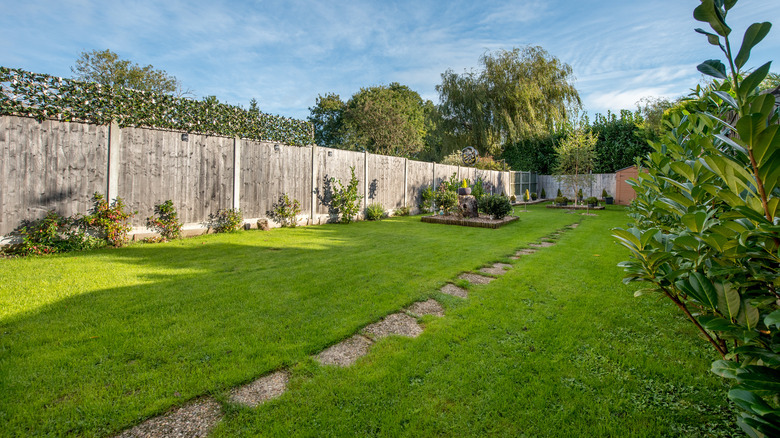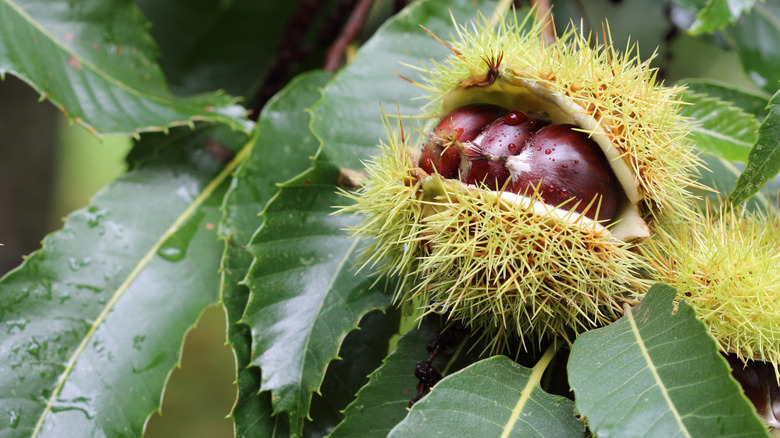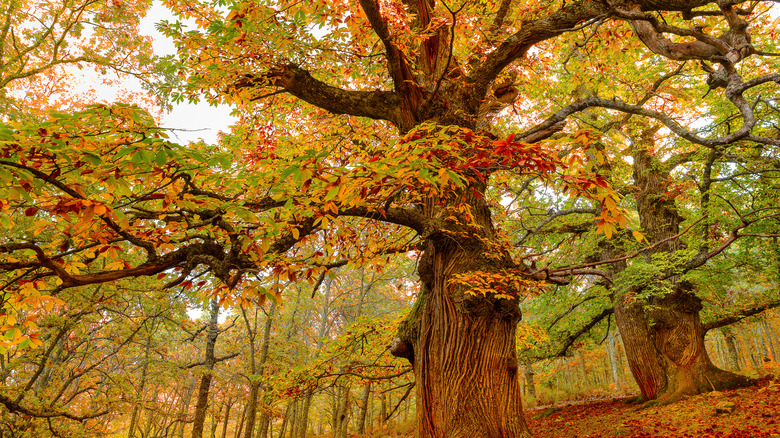This Is One Of The Most Beneficial Trees You Can Grow In Your Backyard
Standing tall at the confluence of ornamental beauty, wildlife value, and nutritional significance, chestnut trees (Castanea spp.) are the most beneficial trees to grace any yard. Cousins to the beech family, they can live for over 100 years and grow nearly 60 feet tall, adding a touch of character, shade, and history to the landscape. Birds and bees add to their magic by descending upon their blossoms and tresses, either for food or cover. Above all, they bring a bountiful harvest to your yard of tasty nuts — and in wintertime, they'll serve as the perfect backdrop to sing "chestnuts roasting on an open fire."
It's worth noting that although the U.S. has its native American chestnut species, it isn't recommended in residential landscapes, given its high susceptibility to blight — the cause underlying the 20th century's decimation of chestnut plantations. Your next best option is Chinese chestnut (Castanea mollissima) trees, whose crop typically floods the farmer markets, as they're hardy against both the blight and the cold in zones 4 through 8. But if you prefer the taste of imported chestnuts from grocery store shelves, consider European chestnut (Castanea sativa) trees. However, be warned that like their American associates, they too suffer from chestnut blight. You can also plant hybrid cultivars available at nurseries. Remember, you'll need at least two chestnut trees within 100 feet for cross-pollination for nut production.
Plant chestnut trees to grow your own stash of nuts
You can grow chestnut trees either by burying the seeds directly into the ground, though they might bring squirrels to your yard. To keep your chestnuts safe from ground diggers, start them indoors. For the latter, sow the seeds half an inch deep in a moist, bark-heavy potting mix around late February, maintaining between 70 and 80 degrees Fahrenheit. Transplant the seedlings in a hole twice the size of their rootball around mid-May in a moist, acidic site. Water them weekly, and erect fences around the young trees to keep varmints at bay. Some staking may also be necessary. Clear the adjoining 2-foot area of weeds and grass. The fast-growing chestnut trees will be ready to produce nuts before they turn five.
Harvesting chestnuts is no easy feat, as they're usually enclosed in spiny burrs, seed pods laced with prickly hair. So wear your leather gloves, shoes, and a hat when they're due for harvesting in the fall. Depending on the cultivar, the burrs may either crack open as they fall or develop seams that can be split apart. Make haste, as deer and blue jays will race you for the seeds. You can collect nuts as they fall on a tarp or rake the produce and sort. If pressed for time, shake the tree lightly to loosen the burrs and keep them aside for a few days until they're ripe for consumption.
Chestnut trees make attractive backyard sentinels but come with some caveats
Succulent nuts aside, chestnut trees benefit their growers by adding ornamental interest to their yards. They celebrate spring by exploding into masses of white flowers called catkins that carpet the floor through the summer. In the fall, their foliage turns their green overcoats into warm bronze hues, appearing breathtaking against the deeply ridged, mature bark. These fast-growing trees also create shade in a hot sunny backyard. The near ground-level branching habit especially helps in keeping the underneath area cool.
However, like every beauty, chestnut trees too have their thorns — literally. Their 60-foot-wide shade has little utility when they're setting seeds. Those porcupine-like burrs hurt, so they're not especially suited to recreational areas, especially around kids or pets. Besides, the leaf and pod litter makes the yards messy, becoming a slip hazard, in addition to harboring weevils that may infect your nuts unless it burnt or disposed. Some may find their smell off-putting or fishy. Also, they won't perform well in shade, necessitating direct sun through the day. Depending on the region, chestnut trees can contract untold diseases, so checking the history is necessary before planting. For instance, blight is a concern in the East, gall wasps in the Southeast, and ink disease across the South. Finally, chestnuts comprise part of the diet of bears, voles, raccoons, turkeys, and loads of other critters, so unless you're ready to invest in tree shelters, avoid planting if their presence is severe.


